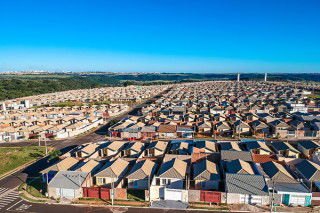As Indonesia’s cement sales growth disappointed last year, the industry is hoping a revival of government infrastructure spending will help overcome recent challenges and return demand levels to higher ground.
From strong double-digit growth rates experienced in the 2011-12 period, Indonesian cement volume expansion has been slowing over the past two years. Latest industry figures show that Indonesian cement sales increased by just 3.6 per cent in 2014, dragged down by higher interest rates, tighter banking liquidity, sharp hikes in retail fuel prices and uncertainty amid the presidential and legislative elections.
While the Indonesian Cement Association (ASI) had targeted sales growth at between 3.5-4 per cent last year, this prediction was a revision of the association’s initial target of six per cent earlier in the year. As such, a local industry source told ICR that total sales figures for 2014 fell far below forecasts and “are much too low for a country such as Indonesia.”
Increased infrastructure hopes
Despite recent challenges, Indonesia is one of five key countries earmarked by Morgan Stanley as a key driver for an acceleration in global cement demand this year, as the election of a reform-minded president could usher a period of stronger government focus on infrastructure investments as macroshocks dissipate. “The fundamentals of the Indonesian economy are strong, with low system leverage suggesting robust growth potential,” the research house comments.
The Indonesian cement association remains hopeful that the new government will push forward infrastructure projects to help drive cement demand momentum. Moreover, with President Widodo, widely known in Indonesia as Jokowi, now having scrapped petrol subsidies entirely from 1 January 2015, the government has markedly more fiscal room. Precisely how Jokowi and his administration plan to spend it will be seen when it submits a revised budget to parliament later this month. However, Taimur Baig, Deutsche Bank’s chief Asia economist, notes that the president’s broad aims are already clear: he wants to boost spending on health, education and infrastructure, as well as bring down the budget deficit.
Commenting on the prospects for infrastructure spend, ASI chairman, Widodo Santoso, said: “Hopefully, the new government can speed up growth of the infrastructure projects. That way, our domestic cement consumption can jump back to a range of 5-6 per cent."
New projects continue apace
Promising growth potential means the appetite for new projects remains strong. The country’s largest cement producer, PT Semen Indonesia, has recently said it has prepared capital expenditures worth IDR7-9trn (US$550m-706m) partly to fund new plants and upgrades as well as for possible further international expansion. Of the total, around IDR5trn would be invested in the new projects in Indarung (West Sumatra) and Rembang (Central Java). According to Semen Indonesia finance director, Ahyanizzaman, the new line in Indarung was expected to start operating in the first half of next year, while the plant in Rembang was scheduled to begin operations by the end of next year, adding 6Mta to the firm's current output of around 31.8Mta. Further funds will be allocated to the upgrade of packing plants. The company is also reportedly is seeking to build a new cement factory in Aceh province, at the northern end of Sumatra. The new facility is expected to have a capacity of around 3Mta to meet increasing consumption in Aceh, Medan, Dumai and Riau.
Indonesia’s second-largest producer, PT Indocement Tunngal Prakasa, brought 1.9Mta of new grinding capacity on-stream last year at its flagship Citeureup works and further expansion is underway for its 14th line at the plant. A recent visit by UBS to ascertain construction progress at the brownfield site revealed that despite a minor delay, the 4.4Mta line is likely to be completed and operational by year-end 2015, as expected.
Semen Bosowa also said this week that it is setting aside US$500m this year to expand capacity in anticipation of a pick-up in demand across the country. The company is building cement plants in Maros (South Sulawesi), Ciwandan (Banten), Banyuwangi (East Java), Rembang (Central Java) and Sorong (West Papua). The plants would boost the group’s cement production capacity to 12Mta over the next three years from 3Mta of present.? ?
PT Conch’s greenfield cement plant came on-stream in South Kalimantan in December, with an installed capacity of 1.5Mta. Construction of the factory began in 2012 and has involved an investment of US$202m. It has the capacity to produce 3200tpd and marks Chinese parent company Anhui Conch Cement's first venture into the promising Indonesia market.
